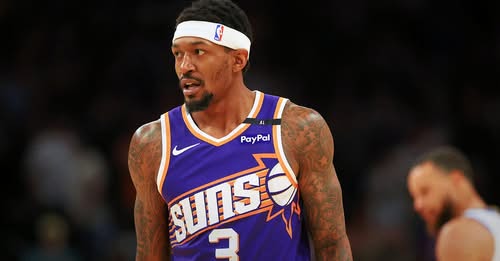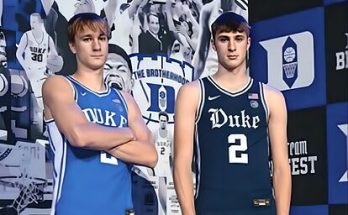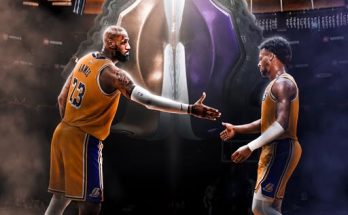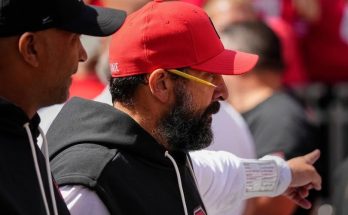The Golden State Warriors have always been known for their boldness in the NBA free agency market, and the latest report that they offered Bradley Beal a minimum deal before he chose to join the Los Angeles Clippers only further cements that reputation. This revelation, though surprising on the surface, speaks volumes about the Warriors’ current position in the league, their evolving strategy, and the perceived value and priorities of players like Beal, who chose situation over legacy potential.
To understand the depth of this report, it’s crucial to revisit the timeline of events surrounding Beal’s movement across the league. After a somewhat underwhelming stint with the Phoenix Suns, where injuries and chemistry issues derailed any consistent progress, Beal found himself being actively discussed in trade and free agency rumors once again. Despite his talent, the shadow of his massive contract and injury history seemed to cool interest from contenders. So when news broke that Beal would be testing the market and was willing to consider minimum offers for the chance at a ring, eyebrows were raised throughout the NBA community. Here was a three-time All-Star, once considered a potential franchise cornerstone in Washington, suddenly looking for a fresh start in a different light.
Golden State’s interest makes sense in several ways. The Warriors, still reeling from a disappointing season and likely one of the last chances to capitalize on the Curry-Thompson-Green era, were aggressively hunting for bench scoring and veteran shooting at a discount. With Klay Thompson’s departure to the Dallas Mavericks and the void it created both emotionally and on the court, the Warriors had to think creatively. Beal, at a minimum salary, would have been a home-run signing—a low-risk, high-reward option that could give the Warriors a new offensive dimension.
But therein lies the rub. For Beal, the Warriors represented more than just an opportunity to contend. They were the quintessential dynasty, albeit aging, but still with Curry’s gravity and championship experience intact. Yet the fact that Golden State’s offer was reportedly a minimum deal may have served as a double-edged sword. On one hand, it signaled that the Warriors viewed Beal as a role player—valuable, yes, but not central. On the other hand, it underscored the salary cap constraints the franchise currently faces. Between the luxury tax concerns and their failure to land top-tier talent in recent years, the Warriors have become increasingly conservative in their financial outlays unless it directly leads to championship contention.
From Beal’s perspective, the minimum offer might have felt like a slight, or perhaps it merely clarified his potential role on a stacked but aging roster. At this stage in his career, Beal likely sought a blend of meaningful playing time, locker room respect, and a real chance to contribute. The Clippers, by contrast, could offer a more attractive package on all three fronts. With James Harden and Kawhi Leonard’s health uncertain at times, there’s an opportunity for Beal to carve out a significant role. Additionally, the Clippers are currently navigating a make-or-break moment, especially with their upcoming move to the Intuit Dome and the urgent desire to finally get over the playoff hump. In that context, Beal’s arrival is not just a bonus; it’s potentially critical.
It’s also worth considering the allure of playing in Los Angeles. While San Francisco is a beautiful city, the glitz and media attention of L.A., combined with the marketing opportunities available for stars like Beal, are hard to overlook. Though the Warriors have had a dynastic run and possess one of the most revered cultures in the NBA, they no longer command the same aura they did from 2015 to 2019. That’s not to say they aren’t dangerous, but they are no longer a juggernaut. Their struggles last season, including chemistry issues, an aging core, and the up-and-down performances of younger players like Jonathan Kuminga and Moses Moody, all added to the perception that Golden State might not be the safest bet for a deep playoff run.
So when Beal chose the Clippers, it wasn’t just about the money—though even a marginally better offer might have helped. It was a reflection of where he saw himself fitting in, both in terms of basketball and lifestyle. And for the Warriors, the rejection stings not because they lost out on a star but because it underscores a growing problem: they’re no longer the destination team for marquee veterans chasing a ring.
This situation also calls into question how aggressive the Warriors are willing to be this offseason. Reports have circulated that the front office, led by Mike Dunleavy Jr., is trying to strike a balance between honoring the core trio that brought four championships and pivoting toward a younger, more sustainable roster. The Beal offer, modest as it was, seemed to be part of that philosophy—a calculated risk that wouldn’t upend their books or alienate developing players but could still add value. That Beal declined indicates that top-tier veterans may want more assurance or spotlight than Golden State can now provide.
There’s also the matter of Stephen Curry’s window. With each passing year, the urgency to maximize his prime—or whatever remains of it—grows louder. The Warriors know they can’t afford mediocrity, especially in a Western Conference that now includes deeper, younger, and more athletic rosters. The Clippers, Thunder, Timberwolves, Mavericks, Nuggets, and Grizzlies all project to be highly competitive. In that context, adding someone like Beal—if he could remain healthy—might have been the boost needed to keep the Warriors in contention.
Instead, they’ll now have to recalibrate. With Thompson gone and Chris Paul traded, the Warriors’ depth chart looks drastically different. Curry remains the engine, but who becomes his consistent sidekick is still up for debate. Andrew Wiggins’ inconsistencies, Draymond Green’s decline, and the inexperience of the bench make it difficult to predict how competitive this team can be without major additions. Beal might not have been a savior, but he could have at least helped stabilize the second unit or share scoring duties with Curry on off nights.
Looking forward, the Warriors are at a crossroads. They still have assets and a legendary coach in Steve Kerr, who has experience integrating stars into a team-first culture. But if they continue to swing and miss on veteran additions like Beal, the path back to championship relevance grows narrower. Their upcoming moves—whether that involves flipping Wiggins or pursuing another shooter—will be under intense scrutiny. It’s no longer enough to rely on the past.
Meanwhile, the Clippers’ gamble on Beal could either pay huge dividends or become another chapter in their long history of high-risk, high-reward decisions. Beal’s health, motivation, and ability to mesh with the other stars will determine if this move propels them to the top or ends in another frustrating playoff exit. Regardless, Beal’s decision to choose the Clippers over the Warriors—despite the Warriors’ pedigree—sends a strong message about perception, opportunity, and the evolution of NBA power dynamics.
In the end, Golden State’s reported offer of a minimum deal to Bradley Beal was a move made out of pragmatism. It reflected a franchise that understands its limitations and is still willing to try to compete without mortgaging its future. But Beal’s rejection is also a reminder that names and rings alone aren’t enough anymore. Players want roles, relevance, and respect. And until the Warriors can consistently offer all three, they might find themselves on the outside looking in when it comes to elite veteran acquisitions.



